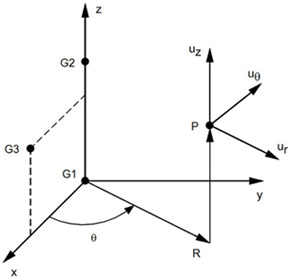Cylindrical Coordinate System Definition, Form 1
Description: Defines a cylindrical coordinate system by reference to the coordinates of three points.
Format:

Example:

| Field | Definition | Type | Default |
|---|---|---|---|
| CID | Coordinate system identification number. | Integer > 0 | Required |
| GiA, GiB | Grid point identification numbers. | Integer > 0, G1A ≠ G2A ≠ G3A, G1B ≠ G2B ≠ G3B | Required |
Remarks:
- Coordinate system identification numbers on all CORD1C, CORD1R, CORD1S, CORD2C, CORD2R, and CORD2S entries must all be unique. One or two coordinate systems may be defined on a single entry.
- GiA and GiB must be defined in coordinate whose definition does not involve the coordinate system being defined. The first point is the origin, the second lies on the z-axis, and the third lies in the plane of the azimuth origin. The three grid points GiA (or GiB) must be noncollinear and not coincident.
- Coordinate systems defined using CORD1C, CORD1R, and CORD1S entries cannot be used as reference coordinate systems on CORD2C, CORD2R, and CORD2S entries.
- The location of a grid point (P in the sketch) in this coordinate system is given by (R, θ, Z) where θ is measured in degrees.
- The displacement coordinate directions at P are dependent on the location of P as shown below by (
 ,
,
 ,
,
 ).
).
- Points on the z-axis may not have their displacement directions defined in this coordinate system since ambiguity results. In this case the basic rectangular system will be used.

Figure 1. CORD1C Definition